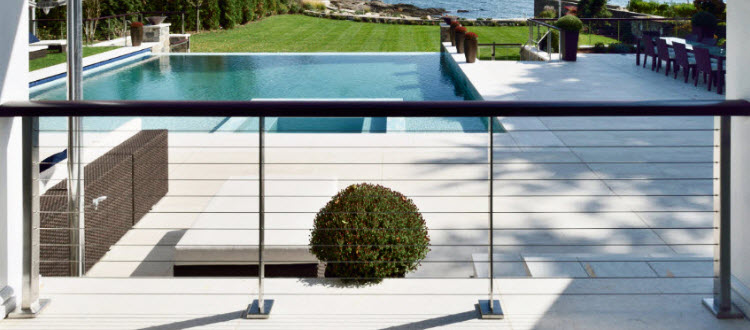Cable Railing Post Material Choices

When purchasing a cable railing system, it’s important that you consider your railing system’s enviornment before chosing materials for the top rail and railing posts.
While the cables and fittings are usually made from stainless steel, we offer a wide selection of top rail and post materials. With so many different choices of railing materials, it can be very difficult to know what the best choice is for your railing. Here is a guide to help you understand the materials we offer and their advantages and disadvantages.
Determine the Railing Location
Is your railing project inside or outside? Is your work site in a corrosive or passive enviornment? Before chosing railing materials, make sure you understand the enviornmental factors that will impact the durability of your railing system.
A) Interior or Exterior – If your project is interior, you have a lot of freedom when it comes to choosing railing materials. Interior railings are not subject to corrosion caused by the natural elements. You can choose from any of our material and finish options without worrying about weathering. If your railing is exterior, you need to consider natural elements such as wind, rain, snow, and extreme temperature swings. Your biggest enemy is water. Water can get inside of posts and cause corrosion. It drips down the cables and runs down the posts where the cable and posts meet. We prefer to use solid material whenever possible since they cannot be penetrated by water and won’t rust from the inside out. If tubing is used, it’s best to have a drain hole for the water to escape so it does not collect water and eventually freeze during the winter months.
B) Passive or Corrosive Environment – Most of the country will fall into the passive category. Although, if your project is within a couple miles of the coast, you will fall into the corrosive environment category. If you live in this environment, you probably already know how corrosive the salt air can be. A salt-dense fog or ocean spray will create a chloride-rich environment that can accelerate the corrosion process of many metals, especially ferrous metals. The best defense is to select a metal or metal coating which inherently resists corrosion. When customers tell us that they are in a saltwater environment, we typically recommend one of three material options: polished 316 stainless steel, anodized or powder-coated aluminum, or hot-dip galvanized and powder-coated steel. The biggest area of concern with all cable railings is where the cables meet with the posts. The cables can rub on the finish and the contact of dissimilar metals can accelerate corrosion. For this reason, we actually press small plastic bushings into each post. These bushing help to prevent contact between the posts and the cables.
Determine Your Budget
Budget can be a big driver of the your material choice. Here is a list of materials in order from least expensive to most expensive.
1) $ Wood – A popular option for railings has always been wood. Wood is by far your cheapest option and also the easiest to work with. The downside is that it does require maintenance and can crack or rot over time. If you are remodeling an existing deck, chances are it was probably a wood deck with wood railings. The good news is that there are many lower-maintenance and longer-lasting wood options out there like IPE Brazilian walnut and mahogany. Many of our customers like the feel of a wood top rail and it complements a metal post nicely.
2) $$ Powder-Coated Steel – Many of the projects we complete use powder-coated steel posts. If the project is indoors or outdoors (but not near saltwater), powder-coated steel posts hold up very well. The post is only as good as the coating that protects it and the quality of the powder coating is all about the person who applied it. Proper prep work and application is everything when it comes to the sustainability of powder coating over steel.
3) $$$ Powder-Coated and Hot-Dip Galvanized Steel – If you are in a coastal environment and looking for a cost effective solution that will hold up in the toughest environment, we recommend powder-coated and hot-dip galvanized steel. Galvanizing the steel will prevent rust for 75 years or more. Steel is very strong and the combination of galvanizing plus powder coating gives you more flexibility in color choices.
4) $$$$ Anodized or Powder-Coated Aluminum – Aluminum has many positives such as being light and easy to work with. Aluminum also holds up extremely well and resists corrosion very well. With a polished finish and a clear anodized coating, you can achieve a look that is similar to stainless steel at a fraction of the price. It’s no wonder anodized aluminum is used extensively for high-performance windows and doors. One drawback is the limited choice of colors and textures. If more color choices are important, aluminum can be powder coated. There are literally 1000s of color choices.
5) $$$$$ Polished Stainless Steel – When stainless steel in properly handled and polished, it’s truly the most beautiful metal. Light reflects off of it from all different angles and it will glisten like a diamond in the sun. Stainless steel is one of the more expensive options (other than bronze or pure nickel) for your railing and it’s also the most difficult material to work with. If you have the means, stainless steel posts are a great option for any environment.
Make a Decision
If you still are not sure what the best material solution is for you, just give us a call and we can help you figure it out. It’s not uncommon for customers to request multiple price estimates so they can compare the cost differences in materials. Unfortunately, there is not a “one size fits all” when it comes to cable railings, which is why we tailor all of our railings to meet the needs of our customers.

